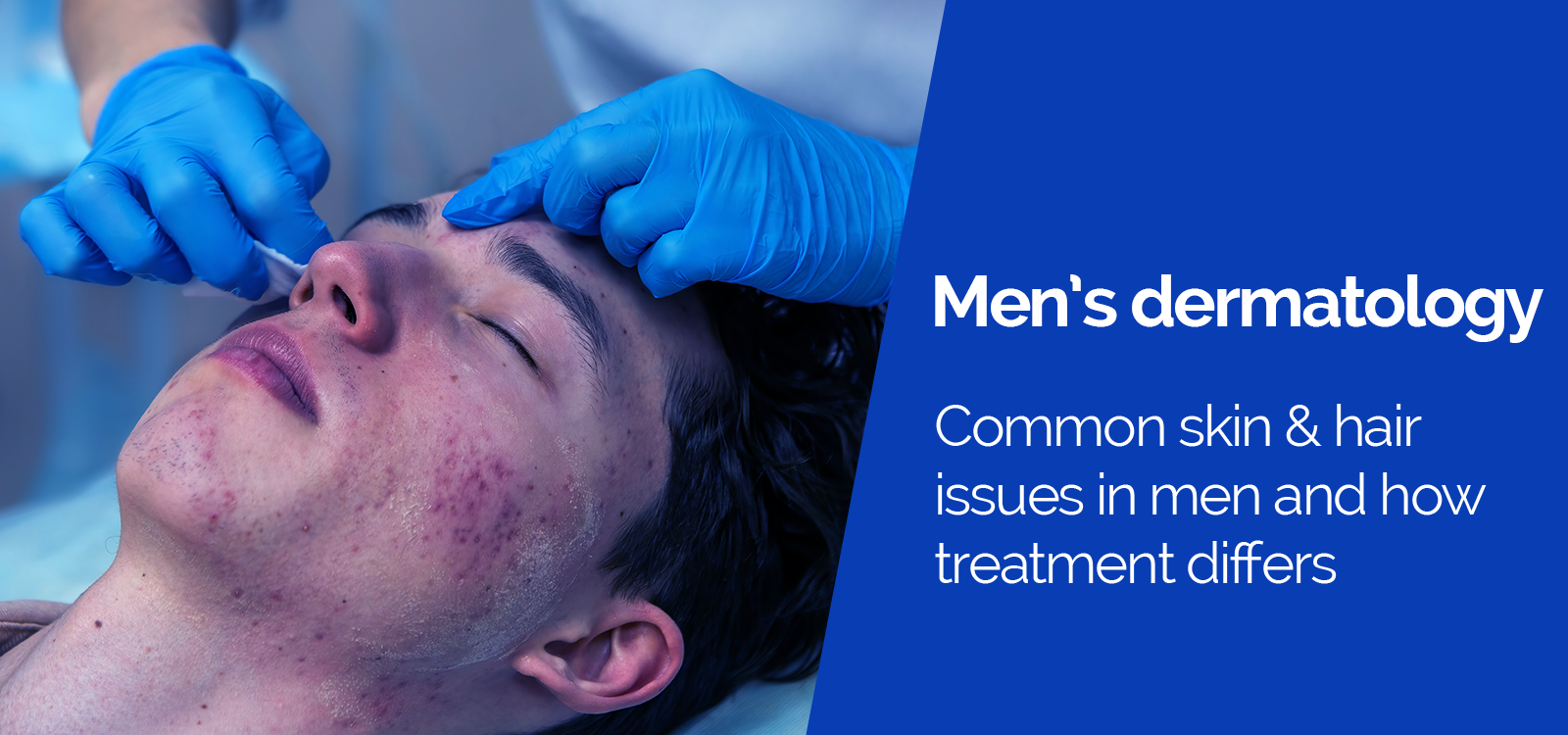Contents
- 1 Why Men Need Dermatology That Fits Their Skin
- 2 Acne in Men. Why It Persists and What Works
- 3 Hair Loss in Men. Why the Process Starts Early
- 4 Anti-Aging for Men. Different Skin Structure Means Different Care
- 5 Daily Grooming and Why It Affects Treatment
- 6 Treatment Methods Used by Men’s Clinics in 2025
- 7 How Dr. Fehmida Approaches Men’s Dermatology
- 8 FAQ
Men are gradually facing skin and hair problems that seem easy to treat, but in reality, the reasons behind them are pretty specific. All these factors, like thick skin, dense follicles, higher sebum levels, and daily shaving, give rise to everything from acne to early hair thinning. General treatment methods cannot address these concerns effectively.
A men’s skin treatment clinic that is familiar with male physiology and psychology will be the one to provide you with the necessary care. This guide highlights the most frequently occurring problems, the latest trends of 2025, and how experts, such as Dr. Fehmida, address them through precise and well-structured plans.
Why Men Need Dermatology That Fits Their Skin
Male skin has higher collagen density and more active oil glands. The texture is stronger and heavier. Shaving adds friction and irritation. Sweat and sebum mix and clog pores. Stress, sleep, and high-protein diets influence breakouts and hair loss. These factors shape how treatment works.
A men’s skincare dermatologist studies these patterns and build plans that match male physiology instead of using generic advice.
Acne in Men. Why It Persists and What Works
Acne trends in 2025 show higher rates in men aged 18 to 40. This links to stress, gym routines, testosterone shifts, and sweat buildup. Men also wash their face less often or use harsh cleansers that strip the skin.
A male acne specialist checks pore size, oil activity, shaving habits, and diet. Treatment includes controlled exfoliation, antibacterial therapy, and texture repair.
Deep cystic acne responds to medical treatments rather than over-the-counter options. Many men treat acne late, which leads to deeper scars. Early diagnosis prevents this.
Hair Loss in Men. Why the Process Starts Early
Recent studies show that more men below 30 report thinning. Genetics guide most cases of men’s hair loss, but stress hormones and lifestyle push it faster.
A proper diagnosis matters. Specialists distinguish hormonal loss from nutritional loss or scalp inflammation.
Men’s hair loss treatment often includes a combination of oral therapy, topical support, and scalp strengthening. When hair falls in defined patterns, hair transplant for men becomes a long-term solution. Modern transplant techniques focus on natural direction, density, and realistic coverage rather than heavy lines.
Dr. Fehmida uses examination, imaging, and growth mapping to plan treatment.
Anti-Aging for Men. Different Skin Structure Means Different Care
Men age at a slower rate at first because of thicker collagen, but once aging starts, the drop is sharp. Fat pads shift. Lines deepen fast. Sun exposure accelerates this.
A men’s anti-aging skin treatment plan focuses on firmness, hydration consistency, and texture improvement. Men often prefer subtle and low-maintenance treatments. This includes collagen stimulation, fine line correction, and controlled resurfacing.
A men’s skincare dermatologist also checks shaving patterns and inflammation, since chronic irritation worsens aging.
Daily Grooming and Why It Affects Treatment
Male grooming habits affect skin health more than expected. Many men use body wash on the face, skip sunscreen, shave daily without prep, or use gym towels on the face.
A male grooming dermatologist reviews daily routines and replaces harmful steps with simpler and cleaner habits. Small changes improve treatment results.
Many men respond well to straightforward plans. Cleanser, a single active ingredient, and sun protection. The strength and type of product differ from those used for women because male skin absorbs ingredients differently.
Treatment Methods Used by Men’s Clinics in 2025
Updated dermatology trends show higher demand for combination plans. Below is a simple table that helps explain how specialists approach male skin and hair problems.
| Problem | Specialist Focus | Treatment Approach |
| Acne | Oil regulation and pore control | Medical cleansers, antibacterial therapy, resurfacing |
| Hair loss | Pattern analysis and root strength | Oral therapy, topical formulas, transplants |
| Aging | Firmness and texture | Collagen stimulation, fillers, resurfacing |
| Shaving problems | Irritation control | Barrier repair, exfoliation plans, blade hygiene |
Clinics now rely on imaging tools that track progress with high accuracy. This guides treatment strength and timing.
How Dr. Fehmida Approaches Men’s Dermatology
Dr. Fehmida assesses skin thickness, follicle activity, and genetic patterns before planning any treatment. Male patients often want clear results with minimal downtime. She designs treatments that fit work routines, gym schedules, and shaving habits. Her clinic focuses on long-term stability instead of temporary improvements.
FAQ
1. Why do men need a different dermatologist for skin problems
Male skin behaves differently, and targeted treatment works faster and stays stable for longer.
2. What is the best acne treatment for men
A male acne specialist examines pore activity and inflammation, then selects medical treatments that reduce oil and rebuild texture.
3. When should men start anti-aging treatments
Start when fine lines or texture changes become visible. Early treatment preserves firmness.
4. What is the most effective men’s hair loss treatment
The best results come from a combination of oral therapy, topical support, and hair transplant planning when needed.5. How do I know if I need a dermatologist instead of grooming products
If issues persist for weeks or cause redness, hair thinning, or deep bumps, professional care gives reliable results.

